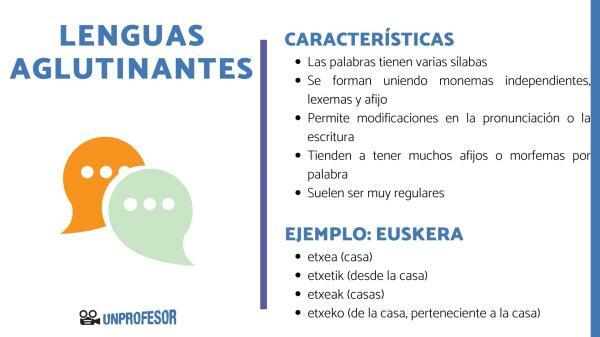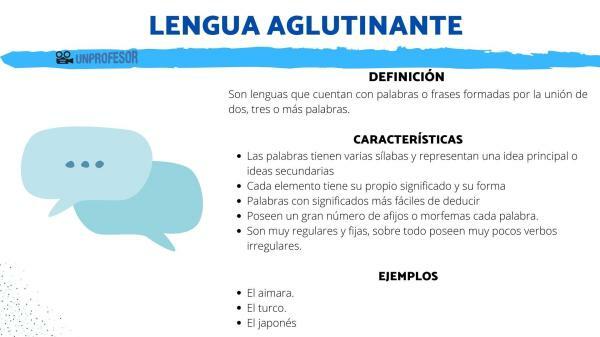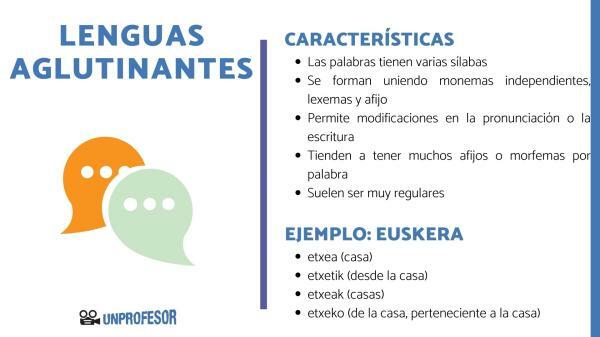5 characteristics of AGGLUTINANT languages and examples

The concept of agglutination refers to the the way words are created, that is, it belongs to the theme of morphology. Agglutinative languages are those that are formed by joining independent monemes, so the meanings of the words are generally easier to deduce.
This can seem like a real mess! For this reason, in this lesson from a PROFESSOR we are going to explain to you what are the characteristics of agglutinative languages and examples practical to make it easier for you to understand this concept.
Index
- What are agglutinative languages?
- 5 characteristics of agglutinative languages
- Examples of agglutinative languages
- Is Spanish an agglutinative or inflectional language?
What are agglutinative languages?
The agglutinating languages are languages in which words are made up of small parts called morphemes and each part has its own meaning. A morpheme is the smallest unit of meaning and cannot be divided into smaller parts, as these would lose their meaning.
The word "binding" comes from a Latin word meaning "paste" or "join". In linguistics, agglutinative languages are a specific type of languages that are classified according to the internal structuring of words.
There is different kinds of languages depending on how words are formed: some languages have words made up of a single morpheme, while others have words made up of several different morphemes. There are also languages that combine characteristics of the two types.
In the case of synthetic languages, which are a type of language made up of several morphemes, they can be agglutinative or inflectional languages. In the binding languages, morphemes have only one meaning and can be clearly distinguished in words. In contrast, in inflectional languages, morphemes tend to combine in a more complex way, making it difficult to separate words into smaller parts.
Concepts of morphology to understand agglutinative languages
To be able to better understand how agglutinative languages work and what their characteristics are, it is good that we review some of the basics of morphology:
- Phoneme: It is the smallest unit of sound in a language, whether it is a vowel or a consonant.
- monema: It is a minimal sequence of phonemes that, when used, changes the meaning. It is like a piece of a puzzle that when added to a word, gives it a new meaning.
- lexeme: It is the part of a word that represents its main meaning. It is what gives us an understandable idea of what the word conveys.
- affixes: They are sequences of sounds that are added to the beginning (prefixes), at the end (suffixes) or in the middle (infixes) of a lexeme to change its meaning.

5 characteristics of agglutinative languages.
Here we leave you the main characteristics of agglutinative languages:
- In agglutinative languages, words have several syllables and can include both the main idea and supporting ideas.
- These words They are formed by joining independent monemes, lexemes and affixes, each with a specific grammatical meaning.
- This allows us understand the meaning of words more easily, since we can deduce it. Additionally, it allows modifications to the pronunciation or spelling of one or more morphemes within a word, which can shorten the word or make it easier to pronounce.
- A common feature of agglutinative languages is that they tend to have many affixes or morphemes per word.
- Besides, they are usually very regular, which means they have few irregular verbs.
For example: In Japanese there are only two irregular verbs, and in Korean there are only ten irregular forms of conjugation, except for the passive and causal forms. However, there are exceptions such as Georgian, which is very agglutinative (with up to eight morphemes per word) but has quite a high number of irregular verbs.

Examples of agglutinative languages.
We are going to introduce you to some examples of agglutinative languages so you can discover how they work more thoroughly.
Basque or Euskera
Basque or Euskera it is the only remaining language of the languages spoken in southwestern Europe before the region was influenced by Latin in the 2nd and 1st centuries BCE. c. It is used in the Basque Country, both in Spain and in France.
In the Basque language you can see examples of agglutination For example, the word "etxe", which means "house", can have different meanings when combined with other words or morphemes. From the same root, words such as:
- etxea (house)
- etxetik (from the house)
- etxeak (houses)
- etxeko (of the house, belonging to the house)
- etxera (in the direction of the house)
- etxerako (going home)
- etxeraino (to the house)
Finnish
the finn is another example of an agglutinative language. Approximately 5 million people speak this language, mainly in Finland and Sweden. There are also speakers in Norway, Estonia, Canada, and Russia.
we can see the clumping phenomenon in the word "taloissani", which means "in my houses". By dividing it into smaller parts, we can identify the following morphemes:
- thallus (house)
- I (plural)
- ssa (within)
- nor (my, my)
Japanese
The Japanese it is a language spoken mainly in Japan and has been isolated from other languages for a long time. Although it has structural differences with Chinese, it has been influenced in its vocabulary and writing system by this language.
In terms of its grammatical structure, Japanese is considered an agglutinative language. This means that it uses suffixes, which are parts that are added to the end of words. Both verbs and adjectives are conjugated according to the tense.
For example, the expression "omoshirokunakatta", which translates as "Not (was/was/has been) interesting", can be split into the following morphemes:
- omoshiro: an adjective meaning "interesting"
- kuna: a particle of negation
- katta: a verb form indicating past tense
Is Spanish an agglutinative or inflectional language?
Spanish is an inflectional language, since morphemes are combined in a complex way. Each word can contain several morphemes that express different grammatical meanings, such as gender, number, tense, mode, etc.
These morphemes merge or combine within the word, so it is difficult to segment them into smaller parts with their own meaning. Therefore, Spanish is classified as an inflectional language and not as an agglutinative language.
For example: I love, you love, love, we love, etc.
We hope this lesson on characteristics of agglutinative languages It has helped you to understand this concept of some languages. If you want to continue investigating this concept or something similar, do not hesitate to consult our section on grammar and linguistics, where we will explain the most difficult concepts of the language, in a pleasant and understandable.
If you want to read more articles similar to Agglutinative languages: characteristics and examples, we recommend that you enter our category of Grammar and Linguistics.
Bibliography
- Garcia, J. m. Q. (1998). Lexicographic problems of agglutinative languages: contemporary Mongolian dictionaries. In Theory and practice of lexicology: V International Conference on the study and teaching of lexicon, Granada 1997 (pp. 133-140). Method.
- Ramos Huamancayo, M. TO. (2018). The languages in the world.

